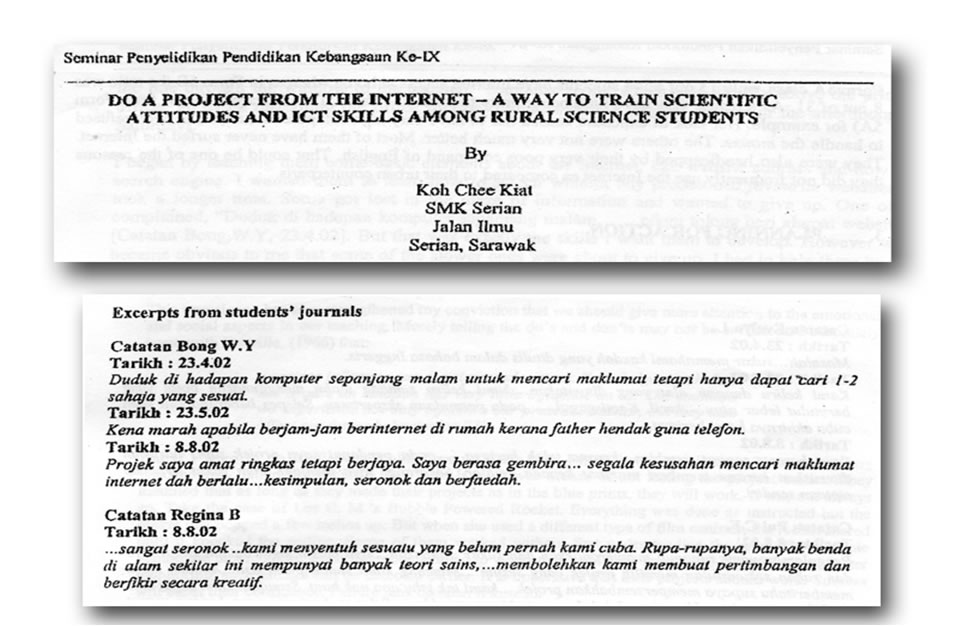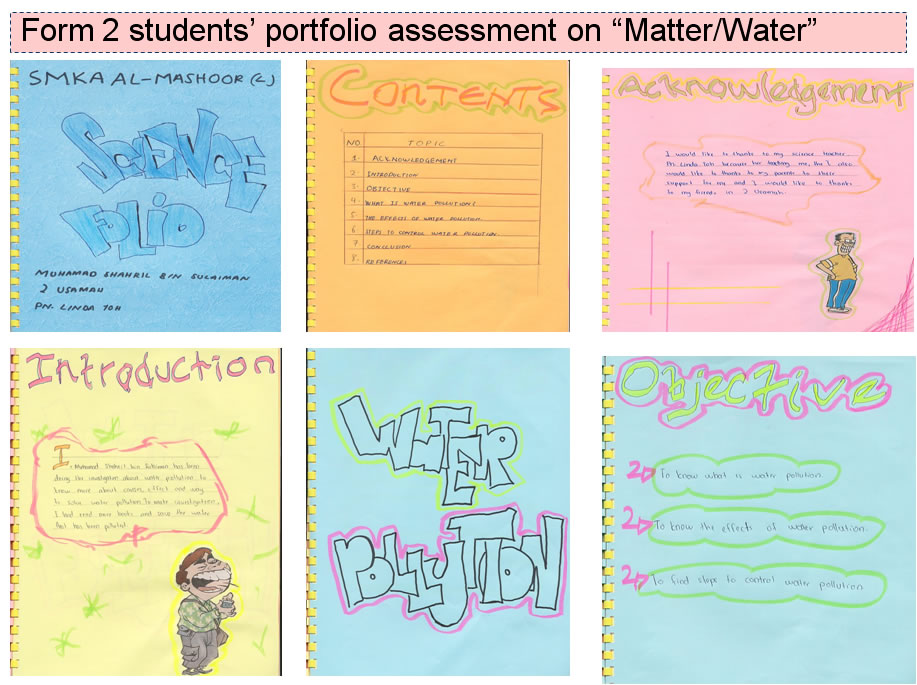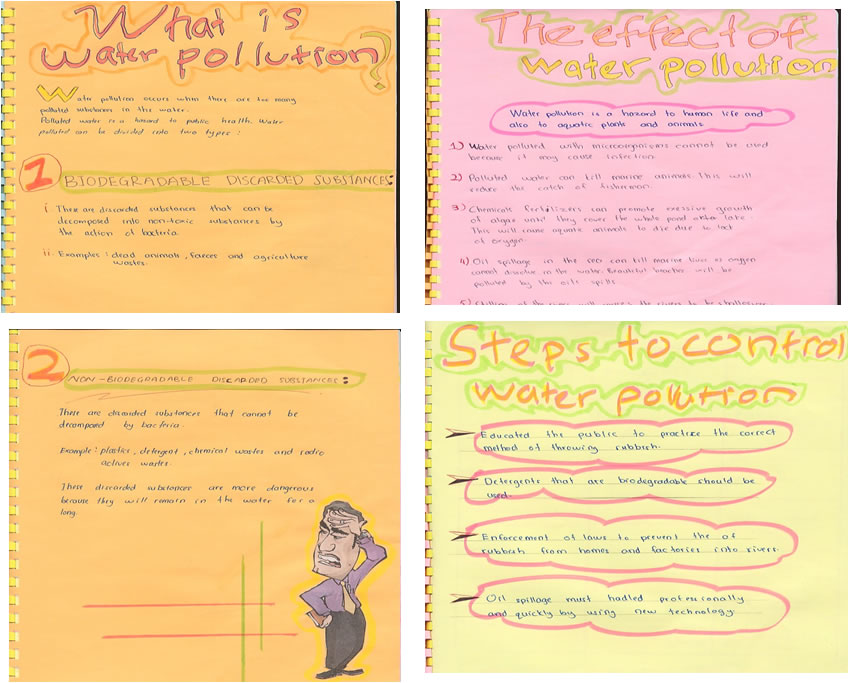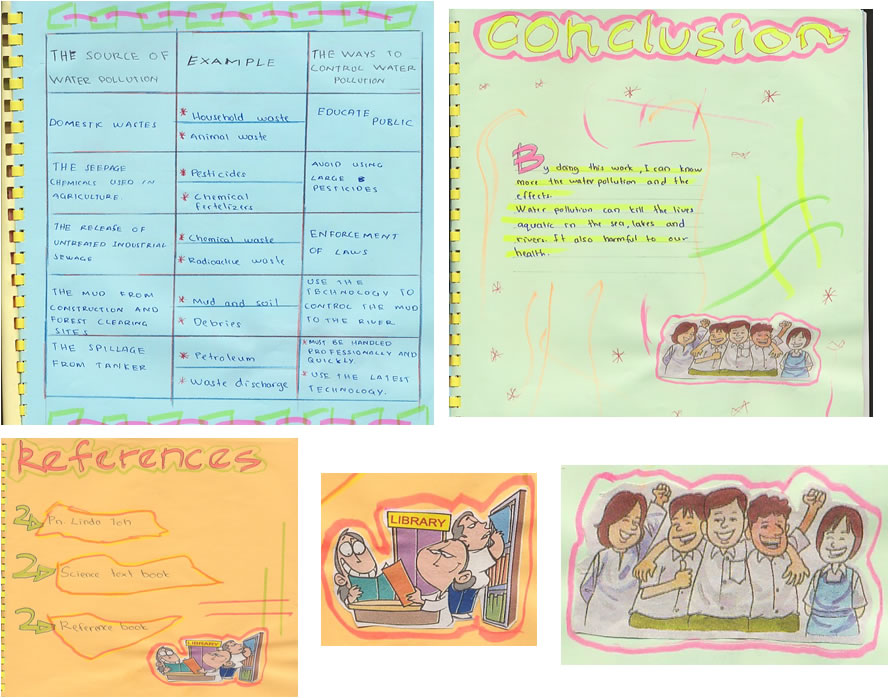<<back
Assessment Methods
Chin Heng Yeap
SEAMEO Secretariat
Ng Khar Thoe
SEAMEO RECSAM
Two Levels of Assessment
Teaching and learning assessment
Project assessment
1. Definitions
2. Assessment of Teaching and Learning
2.1 Purposes
2.2 Principles/Guidelines
2.3 Indicators
2.4 Strategies, methods and records
(the availability of the strategies for doing assessment)
1. Definition of Assessment
lThe process of gathering and collecting information from multiple and diverse sources in order to develop a deep understanding of what students know, and can do with their knowledge as a result of their education experiences. The process culminates when assessment results are used to improve subsequent learning
(Teaching effective programme: University of Oregon)
2. Assessment of Teaching & Learning
Assessment of Teaching and Learning
l2.1 Purposes of Teaching-Learning (TL) Assessment
lTo determine the extent to which the objectives of TL have been attained (current knowledge, perceptions, skills, behaviour etc.)
lTo monitor students’ progress
lTo provide feedback information for improving TL
“Assessment and instructions are both related, if you don’t make that connection, then assessments are not meaningful and don’t help us at all” (Higuchi, 1995)
lTo provide feedback data for the project assessment
lNature of Values/Difficulties in assessing the values a person holds
lValues are abstract, cannot be seen, heard, touched, smelled or tasted until expressed verbally or in action
Verbal: I think…, we should…, I want…,
Action: following direction, compulsion, please others, habit, commitment (internalisation)
lTalks and actions are not consistent
→evaluate verbal expressions and actions
→authentic situation
Nature of Values/Difficulties in assessing the values a person holds
lIt takes a long time to develop human values
→may not see any significant changes even after a course
→evaluate continuously
Values manifested are inconsistent from situation to situation
→multiple ways
→multiple information sources
lDifficulties in assessing values
The assessors:
-Subjective – using his values perspective to interpret and judge
-Not at the right time and situations
Too many students to take care off
l2.2 Principles/Guidelines … (1)
lGeared towards the objectives of a lesson (and subsequently the goals of the Project)
lCover 4 components: knowledge, skills, attitudes and values, behaviour
lValues: utility values and human values
lEvaluation of values: Subjective and low reliability
Principles/Guidelines … (2)
Compensated by having:
-Multiple sources of info: teachers, parents, students (peers and self)
-Multiple ways: paper-and-pencil, observation, interview, reflection, self account targeted at different levels of values expression
-Situations/Activities – both inside and outside classrooms.
2.3 General Indicators (Cognitive)…
Students are able to:
-Recall a fact or concept, e.g. water pollution
-Predict a future event, eg, the amount of water needed by a certain pop in 10 years’ time
-Use knowledge to solve problems, e.g. addition and multiplication to calculate water bill
2.3 Indicators (Cognitive)…
-Analyse a problem, eg what are the various activities contributing to the shortage of water ss to the urban poor
-Synthesis information, eg, gathering info fr various sources and come out with a plan to start a campaign in schools
-Evaluate a programme, eg, evaluate a certain policy with regard to the ss of water
2.3 Indicators (Thinking Skills)
-Give reasons or rationalise an action, eg
-Relate a happening, an action or an event to another, eg deforestation and floods
-Create something useful – draw a poster to depict the conditions when water in shortage
Students:
-Aware of certain values but have not put them into practice, eg uses of water in religious practice
-Able to perform some activities under instruction, eg turn off taps while brushing teeth
-Express willingness to practice certain values, eg, state willingness to collect rain water for gardening purpose
-Voluntarily or choose to practice certain values, eg report leaking water pipes in public areas
-Practice certain values persistently & consistently, eg relentlessly advocating lower water cost for poor people
-Persuade others to practice certain values, eg participate in campaigns advocating water conservation
Four main strands
-Water, environmentally sustainability development
-Water, social equity and human dignity
-Water for health, sanitation and recreation
-Water in culture, traditions and religious practices
2.3 Indicators-Water and Env.
Knowledge
-Recall concept of water conservation
-Recall the methods to save water
Thinking Skills
-Give reasons why one should use recycled water for gardening
-Relate current water conservation effort to the welfare of future generations
Values
-Express willingness to save water in daily life
Behaviour
-Turn off the tap while brushing teeth (and many other activities)
-Taking part in save water campaign
-Persuade others to save water
Knowledge on the Values of Water
-Able to list the functions of water
-State that water is important to health
-Explain that water is part of the structural component of many chemicals
-Gather information and make a report about the use of water in industry
Values – Taking social responsibility
-Informing others thro’ writing articles about the impt. of water in life, religious practices…
-Sing a water festival song – Loi Krathong
-Express appreciation of rivers or canals, after participating in Loi Krathong
-Express the mood of Loi Krathong orally or in writing, including in the expession human values such as asking for forgiveness
2.3 Indicators (Values)...
-know the facts and concepts of water conservation
-Turn off water tap while brushing teeth (and many other activities)
-Express willingness to take part in water conservation
-Participate in water use campaign
-Persuade others to conserve water
-Tests, exercises, reports of experiments and projects etc.
-Self report – journal writing, commitment statement, reflection, portfolio, etc.
2.4.1 Observational Decisions
-Where are they to be observed?
-When and how to observe?
The Purpose of Observations
-To gather data which are difficult to obtain by other means
-To gather data to supplement or verify information
-To gather directly primary data from a more accurate description and interpretation
-To gather data in a laboratory or elsewhere through experimentation (eg science experiment).
Types of Observations
Participant (PO)
-The observer personally takes part in the activities of the things or groups being observed
Non-participant (NPO)
participating in the activity of the group
-The observer merely stand by and observes the things or groups he is studying about


Advantages
-Provides a holistic picture
-Is effective in classroom and playground situations
-Can document non-verbal behaviors
-Increases the researcher’s sensitivity to multiple variables
Disadvantages
ýIt might be difficult to isolate specific behaviors
ýMust use multiple observations for validity
ýTime consuming and labor intensive
ýMay be distracting to participants
Observational Tools
2.4.2 Checklist
 a listing of specific criteria which a teacher looks for, and indicates the presence of , in observing a student’s work .

Checklist …
-Formats for checklists should be varied and easy to use. Some guidelines for constructing and using checklists follow:
-Determine the observation criteria from curriculum objectives and student needs.
-Review criteria with students prior to the observation.
-Choose criteria that are easily observable to avoid vagueness and increase objectivity.
-Structured conversation to collect data
-Systematic analysis of data; coding and decoding data, categorisaton/classification and make inferences
-Advantages: probe to get in-depth information
-Small sample and data not generalisable
-Moral dilemma situation – conference of two or more values (e.g. preservation vs development for a water project)
-Students are compelled to choose a course of action
-Students give reasons for the choice
-Evaluate the reasons [application of values learned (able/unable) or hierarchy of moral reasoning by Kohlberg and Rest etc.]
An Example of Moral Dilemma
-In order to prevent a severe flood in Bangkok, there was a proposal to redirect the water in the upper Chao Phraya River to the nearby areas in Ayutthaya and Ang Thong. However, this action would destroy crops and flood the houses in the two areas concerned, and thereby, causes hardship to their residents. You are given the authority to take an action. Would you want to redirect the flow of water? What are the reasons for your choice?
lApplication of utilitarian principle – balance of number, where greater number should get the greater benefit
Grading for Moral Reasoning
Able or unable to give a moral reason to support a decision made.
Values must be acceptable.
Hierarchy of moral reasoning (Kohlberg' 6 stages of moral development & Rest's 3 moral schema): personal, societal and universal/principled
-Reflective Journal and diaries
-Attitudes scales, eg. Likert scales
2.4.5 Reflective journal or diary
-A useful tool as strategy of “self report” for students to:
-do reflection (rethinking, deeper thinking or recalling)
-express their ideas, feelings, emotions which they may not do in the classroom, esp. for students who are shy to express themselves in classroom
-communicate with teachers in case study (as illustrated) so teachers have better sense of what students’ problems are.
Reflective journal or diary
-It is in the form of loose structure with guided questions to help students to:
(a)explain their ideas in calm and quiet environment
(b)do recording which is free from structure, do not need to care much about language error and expression is more important which may include graphics, picturesque reports, etc.
Examples of student’ reflective journals with picturesque report of field study (MS word)
Example of reflective journal

-A collection of students' work sample to serve as evidence of learning
-Consists of written work, drawing, tape recording, compilation of collection of pictures, artifacts, etc.
-For monitoring and evaluation of the progress of students



2.4.7 Survey and Questionnaire
Surveys and questionnaires are useful tools for collecting data from a large no. of people.
Items must be limited to the assessment questions and design.
Field test the questions with three to five people.
Provide a short explanation of the assessment, explain the
purpose of the questionnaire and how the data will be used.
The formats of different questions will yield different types
of data.
Using a computer may save time in organizing and analyzing
the data.
Advantages
Efficient means of gathering large amounts of data
Respondents can be anonymous
Rating scales yield data that can be displayed in tables and charts
Useful for pre- and post-intervention data gathering
Disadvantages
Lack the richness of personal interviews or direct observation
Open-ended questions are time consuming to analyze
Questions must be worded clearly to avoid misinterpretation
Cascading effects of VBWSE
•First generation of VBWSE: Curriculum developers
and resource persons
• Second generation: Trainers attending the TOT
regional training course
• Third generation: In-service teachers attending echo
training workshops conducted by master trainers
|